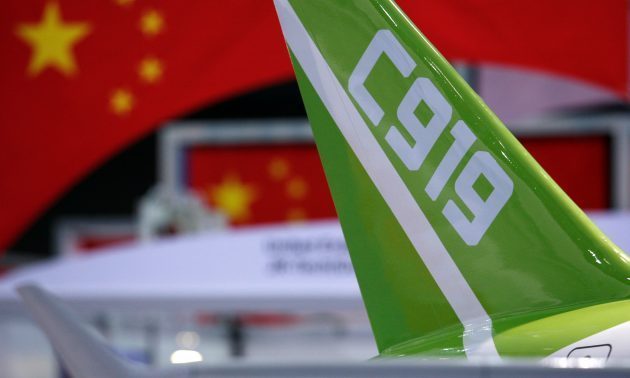[ad_1]
The Commercial Aircraft Corporation of China (Comac) says that its C919 homegrown, narrow-body jetliner is on schedule to take to the skies this year, despite geopolitical headwinds that had threatened to keep the plane on the tarmac.
Six C919 prototypes are now shuttling between Shanghai and Xi’an for airfield and flight tests simulating emergencies and extreme conditions to assess its performance and safety, the state-run Comac said in a statement.
The Shanghai-based company recently said the plane is primed for its first commercial flight by the end of the year or in early 2022, depending on how quickly it receives airworthiness permits from relevant government regulators.Â
The US-China tech war had threatened to ground the plane. The single-aisle jet relies on Western-made components including advanced engines furnished by America’s GE Aviation and its French partner CFM. Trump slapped an export ban on Comac late last year in the waning days of his tenure. It remains in place under the Biden administration.Â
But Zhao Keliang, a deputy chief designer of the C919 project, said in recent local press interviews that many foreign companies continue to support the airliner project and that GE and its partners would still ship engines to Comac to fulfill their contractual obligations, as the related deals were signed before Trump’s imposed sanctions.
“We continue to take delivery of engines from GE Aviation at our Shanghai assembly plant and we are sitting on a big stockpile of vital parts and components sourced from abroad,†said Zhao, who oversees the C919’s aerodynamic and pneumatic designs as well as related test flights.Â
He said that China’s aviation sector self-sufficiency drive has filled some of the parts gap through indigenous production and that Deputy Premer Liu He was also in the process of brokering deals between Comac and non-American firms in the West to procure key parts.Â
“GE’s engines are ideal for the C919 because all designs anchored around the engine powertrain but [after the US export ban] there have been talks of using engines of the Chinese Air Force transport aircraft like the Y-20,†Zhao said.Â
“Another way is to buy engines from Europe, Canada, Russia and even Brazil, from suppliers whose goodwill and business interest better dovetail with the need of the C919… we seek to sign long-term deals when we still need time to develop domestic engines that are up to the task,†Zhao said.
“This will not affect the certification process too much as even Boeing 737s and Airbus 320s use more than one type of engine,†he added, referring to the US and French-made commercial airliners the C919 is designed eventually to compete against for global market share. Â
One technician in Zhao’s team revealed to Asia Times through email correspondence that the biggest challenge now was how to integrate various parts and systems sourced from American and other Western suppliers into a fuselage designed specifically by Comac.
“We found in test flights after the C919’s maiden flight back in May 2017, already three years later than originally planned, that the initial fuselage was too heavy and bulky and to get it airborne GE’s engine consumed more fuel than designed,†said the designer, who spoke on condition of anonymity.Â
“There are two ways to solve this: to fly the same fuselage but we need bigger wing tanks for additional fuel – that means less fuel efficiency and likely a shorter range. Or we can trim the size and weight of the fuselage, but then we have to sacrifice payloads like the plane’s passenger and cargo load,†the Comac technician said.
“Either way we take, the C919 will be far less competitive compared with [Boeing] 737s and [Airbus] 320s. Then we decided to make use of cutting-edge composite material like special aluminum to make lighter airframes.â€
He also hinted that there was a “modicum of progress†in a Comac reverse-engineering effort underway to study the GE-made engine to emulate and master core technologies including blade design.
Once approved for commercial take-off, the C919 will accommodate about 158 passengers on maximum range journeys of 3,000 nautical miles. By comparison, the Airbus A319neo can fly over 3,600 nautical miles while the Boeing 737 MAX 7 can travel over 3,800.
Still, Comac has so far released scant details about the C919’s airworthiness approval process.
Wu Guanghui, the program’s lead designer, was recently quoted by a WeChat news account maintained by Shanghai government’s Media Office as saying that the C919 was on track to secure European Union Aviation Safety Agency’s (EASA) market entry approval by the end of the year.
He said the C919 has recently wrapped up its EASA extreme low-temperature tests over 23 days in January at -35 degrees Celcius, according to the report.
Wu also said testing conducted in the airspace above China’s alpine Qinghai-Tibet plateau had progressed at “warp speed,†cramming the usual half-year of testing into about three weeks with data fed live to EASA technicians.
The Shanghai-based China Eastern Airlines is set to fly the first commercial flight on a domestic route upon the C919’s official approval and delivery.Â
Read more:
[ad_2]
Source link













